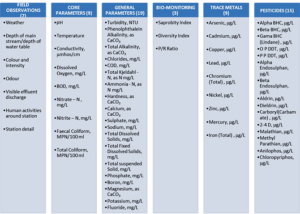About National Water Quality Monitoring Programme
The Central Pollution Control Board (CPCB) in association with State Pollution Control Boards (SPCBs) / Pollution Control Committees(PPCs) is monitoring the quality of water bodies across the country under National Water Quality Monitoring Programme (NWQMP) which indicate that organic pollution is the predominant cause of water pollution
National Water Quality Monitoring Network
CPCB in collaboration with SPCBs in the States and Pollution Control Committees (PCCs) in Union Territories has established a National Water Quality Monitoring Network in order to assess the status of water quality and to facilitate for prevention and control of pollution in water bodies.
Monitoring Network: Present water quality monitoring network under NWMP comprises 4111 stations on surface and groundwater in 28 States and 8 Union Territories. Monitoring is carried out with a frequency on monthly, quarterly, half yearly and yearly basis.
Parameters Monitored:
- Water samples are analysed for 9 core, 19 general parameters,9 trace metals and set of pesticides as per the Guidelines on Water Quality Monitoring , 2017 issued by Mininstry of Environment, Forest and Climate Change (MoEF & CC).
- Analysed water quality parameters are compared with the designated best use water quality criteria recommended by CPCB or primary water quality criteria for outdoor bathing notified under Environment (Protection) Rules, 1986 or BIS Drinking Water Specifrications i.e. IS:10500-2012 or water quality standards for coastal water depending on the use of water bodies.
Achievement of Monitoring Programme :
Water quality data is used for identification of polluted water bodies, identification of pollution sources in cities for formulation of River Action Plans including interception, diversion and treatment of municipal wastewater, waste management and stricter surveillance of industrial pollution sources
Water Quality Assessment:
- Monitoring results obtained based on the present network indicate that organic pollution continues to be the predominant source of pollution of aquatic resources.
- The organic pollution measured in terms of biochemical oxygen demand (BOD) & Coliform bacterial count gives indication of extent of water quality degradation in different parts of the Country.
- Total & Faecal Coliform which indicates presence of pathogens in water bodies is also a major concern.
- Based on exceedance of water quality criteria limits, 351 polluted river stretches are identified in 28 States/3 Union Territories during 2018 based on the analysis of data for the years 2016 & 2017.
Parameters under National Water Quality Monitoring Programme:

Major water quality issues
- Pathogenic (Bacteriological) Pollution
- Oxygen Depleting organic pollution
- Salinity
- Toxicity (micro-pollutants and other industrial pollutants)
Surface Water
- Eutrophication
- Oxygen depletion
- Ecological health
Ground Water
- Fluoride, Nitrate, Arsenic, Iron & Sea water intrusion
















